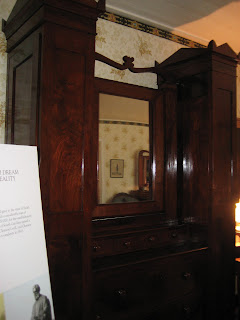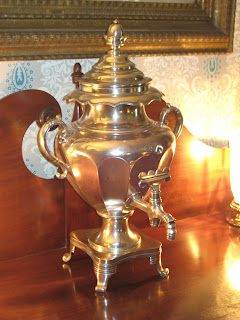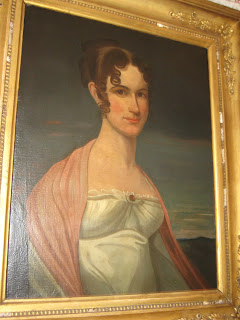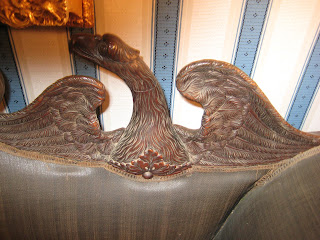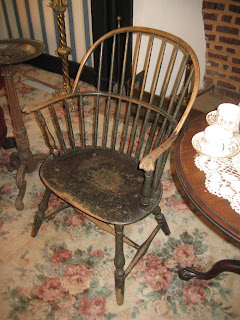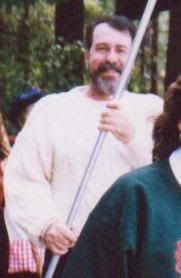A very special thank you goes to Kathy McLellan at Fort Hill who gave us a personal tour a half hour before she was supposed to close a few weeks ago. We made an impromptu stop on the way back from GMHG and found out from Kathy and Will Hiott, the director/curator of Fort Hill and surrounding historic homes that another reunion is being planned for the Calhoun family next year. The reunion also will include the surrounding families and tours of their historic homes, for instance the Hopewell Plantation of General Andrew Pickens. Details are still being formed and the planners would like to hear from you now. Will and Kathy can be mailed at Department of Historic Properties
Box 345615
101 Fort Hill Street
c/o Trustee House
Clemson, Sc 29634-5615
Phone: 864-656-7920 ; 864-656-2475
email: hiottw@clemson.edu ; mkathle@clemson.edu
Fort Hill was the home of John C., Floride Calhoun, and their children between and 1825 and 1850 (for Mr. Calhoun, the year he died), and Mrs. Calhoun and her children, several years after 1850. The plantation was 1,100 acres, less than 500 of which was cultivated.
John C. Calhoun renamed the home Fort Hill from the original name "Clergy Hall". The original home was erected around 1803 by Rev. James McElhenny, pastor of the nearby Old Stone Church. The name Fort Hill was a tribute to Fort Rutledge, which had protected the area from Indian attacks in 1776, and for the hill upon which it was built. It's a combination of Federal Style and Greek Revival architecture.
Thomas G. Clemson
John and Floride's daughter Anna Maria Calhoun (1817-1875) inherited Fort Hill in 1866. Anna died in 1875 and left Fort Hill to her husband Thomas G. Clemson. Mr. Clemson was a scientist, mining engineer, diplomat to Belgium, and is considered to be the first secretary of agriculture. He lived until 1888 (he was 81) and willed the plantation to the state of South Carolina to create a college of agriculture and science. Mr. Clemson's intention was to better the lives of people living post antebellum South Carolina. Life in the South after the Civil War (called Reconstruction) was difficult and many areas never recovered.
Thomas G. Clemson
Anna Maria Calhoun Clemson
Anna Maria with her children Calhoun and Floride
Anna and Thomas had two children: a boy John Calhoun (who went by "Calhoun") and a girl Floride, both named after Anna's parents.
Spring house in front of the main house (used as a refrigerator).
Thomas Green Clemson sitting out on his front porch to greet you.
In 1888 his will stated: "It is my desire that the dwelling house on Fort Hill shall never be torn down or altered, but shall be kept in repair, with all the articles of furniture and venture which I hereinafter give for that purpose, and shall always be open for the inspection of visitors."
Boot scrape.
This portrait is in the hallway and was used for the banners on the light poles outside. It was painted in 1825, the year the Calhoun family moved into Fort Hill. The house was first built by a Presbyterian minister in 1803 as a "four up and four down" meaning a square house with four rooms each upstairs and downstairs. After 1825 the Calhouns enlarged the house to accommodate 10 children, seven of whom lived to adulthood. Legend says that Floride added a room to the house each time her husband was away in Washington.
Before the age of 25, Floride had given birth to four children: Andrew Pickens (1811-1865), Floride Pure (1814-1815), Jane (1816-1816) and Anna Maria (1817-1875). The Calhouns six youngest children were Elizabeth (1819-1820), Patrick (1821-1858), John Jr. (1823-1855), Martha Cornelia (1824-1857), James Edward (1826-1861) and William Lowndes (1829-1858). Cornelia, crippled since childhood, had been her mother’s constant companion. Mr. Calhoun had a garden developed just off the south portico for Cornelia to enjoy.
Four years after her husband died in 1850, Floride sold the Fort Hill house and plantation to her son Andrew and moved to Pendleton, where she lived at a much smaller house she called Mi Casa. During the decade before the Civil War, five other children died (John Jr., Cornelia, Patrick, Willy and James). With the death of Andrew in 1865, Floride regained control of Fort Hill. Upon her death the following year, she willed it to her surviving child, Anna Maria Calhoun Clemson. Floride Calhoun was buried next to her children in St. Paul’s cemetery.
Mrs. Floride Bonneau Colhoun Calhoun later in life
In a part of the original home called the Family Dining Room is a glass case with several items in it.
Family Dining Room with Beehive Oven
Here's two items from the case:
This miniature is of Patrick Calhoun, John C. Calhoun's father. Patrick was born in Ireland and immigrated to the US as a child (about 5 years old?) with his parents James and Catherine (Montgomery). James, the immigrant father, died before the family left Pennsylvania; Catherine, his mother, was killed in the Long Canes Massacre (by Indians) along with another of her sons also named James. Patrick erected a stone marker at the site.
The Master Bedroom
Kathy told us 90% of the furniture in the bedroom was used by the Calhouns during their lifetimes. The four poster bed was with them in Washington.
Mrs. Floride (pronounced Flor-reed) Calhoun's dresser with the light on it.
Mrs. Calhoun designed this wardrobe herself. It has closets on each side for hanging clothes. It is a Piedmont wardrobe made by William Knauff.
Peeking around the side of the wardrobe is this portrait of Mr. Calhoun. Done later in life, he was suffering from tuberculosis (commonly called consumption then) which affected his appearance. Normally very tall and thin during his life the lung disease made him gaunt but only for about the last ten years or so of his life. When he moved in to Fort Hill, he looked like the painting reproduced on the banner at the top of this post. I purposely use a portrait from John C. Calhoun's days as Secretary of War at our clan tent. I don't think as many people have seen it as they have the array of gaunt photographs and paintings one sees from the last years of his life.
This chair is an early recliner for Mr. Calhoun.
Some of these boxes are portable desks.
Mrs. Calhoun's dresser.
Mrs. Calhoun's foot warmer.
The Dining Room
I believe these are water buffalo horns from Mr. Clemson's time. One of the sideboards in the dining room was made from mahogany from the USS Constitution and presented to Secretary Of War Calhoun by US Senator Henry Clay.
Original lithograph.
Sideboards.
The Calhouns’ banquet table and chairs were designed by Duncan Phyfe around 1820.
The Parlor
Anna Maria Clemson's piano.
Floride Calhoun's pianoforte.
The two busts were done from life masks of John C. Calhoun.
Kathy told us this painting was done about the time of Mrs. Calhoun's wedding which would put her at about 18 years old in 1811. Miss Floride Bonneau Colhoun was John C. Calhoun's first cousin once removed.
Wine bottle.
Anna Maria Calhoun and Thomas Clemson were married in this room in 1838.
This bust is a 20th Century interpretation of Mr. Calhoun.
These two statues depict George Washington (nearest) and John C. Calhoun.
Mr. Clemson's palette.
This plate was picked up off the streets of Paris about the time of their Revolution by a family member. St. George and the dragon is depicted in the middle.
Sofa from the Washington family
Eagle on the side.
Dolphin feet.
This chair General George Washington's camp chair during the Revolution.
Upstairs:
Thomas Clemson's seven foot bed made especially to accommodate his 6'6" height. Regular beds made at the time were always shorter than modern beds.
This is Thomas Green Clemson's trunk that he took overseas as an ambassador. The initials are TGC on the top. Kathy told us he had this trunk purposely made with a rounded top so it would always be stacked on top of the other trunks when it was loaded with them on a train or a ship. It was less likely to be damaged that way and it would be unloaded first.
The item on the right is a Hat Tub.
The item with the handle is a bed warmer. Coals would be put in the container on the end.
Another tub in the corner.



















